Discover the Best Closet Organization Systems for Your Space

A great closet organization system is one that clicks with your space, your budget, and how you live. They generally come in three flavors: modular kits, custom-built solutions, and DIY projects. But a good system does more than just hold your clothes—it helps create a stress-free morning by putting everything you own in plain sight and within easy reach.
From Closet Chaos to Calm Control
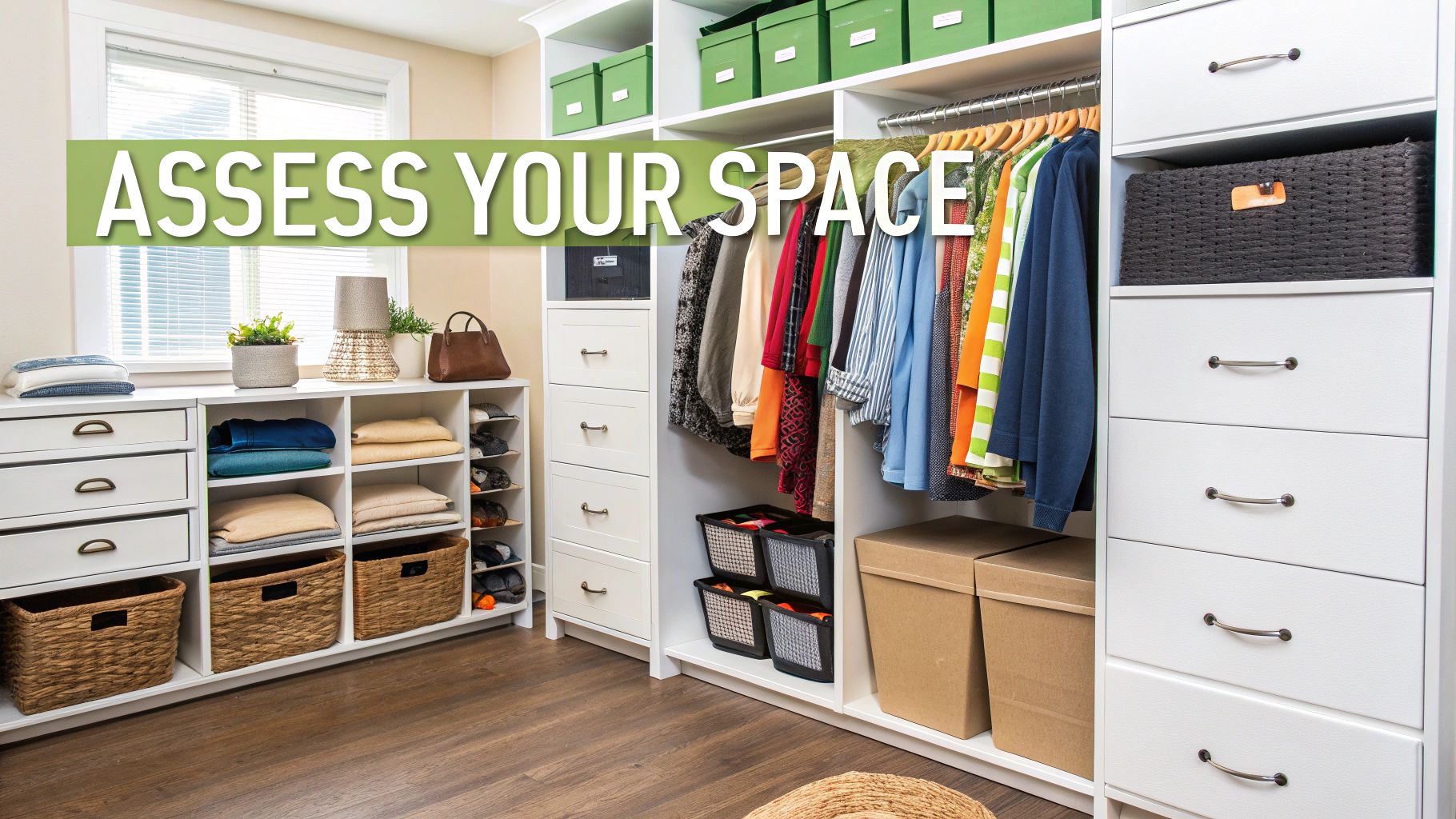
Let's be honest, a disorganized closet is more than just a mess. It’s a daily headache. Digging through a mountain of clothes, fighting with tangled hangers, or hunting for a matching shoe can inject a dose of stress right into your morning. This guide is your map to taking back that space and turning it into a streamlined, functional area that actually brings a little calm to your daily routine.
Think of the right organization system as the blueprint for your wardrobe. A house needs a solid frame to stand, and your closet needs a structure that can support everything, from chunky winter sweaters to your most delicate accessories. When you have a well-designed system, everything has a home, which is the secret to keeping things tidy for good.
Why a System Is Your Best Organizational Tool
Just tidying up a messy closet is a temporary fix. Without a real structure in place, the clutter always creeps back in. A dedicated closet system gives you the framework you need to keep your wardrobe in check, permanently.
Here’s how the right setup can change your closet organization game:
- Maximizes Every Inch: Most systems are designed to take advantage of vertical space and those weird, awkward corners that usually go to waste.
- Protects Your Wardrobe: Giving your shoes, handbags, and folded clothes proper storage prevents them from getting damaged and helps them last longer.
- Saves You Time: When you can see what you own at a glance, getting ready is suddenly faster and way more enjoyable.
- Reduces Stress: It’s a fact—an orderly space can lower anxiety and help you start your day with a more positive outlook.
Before you even think about buying new shelves or rods, the most important first step is to pare down what you already own. We've got some fantastic tips in our guide on how to declutter your closet that will help you start with a clean slate.
An organized closet isn't about having a space that looks like a showroom; it's about building a functional system that makes your life easier. The real goal is to spend less time managing your things and more time actually enjoying them.
In this guide, we'll walk you through the main ways to achieve closet organization. We'll dive into the flexibility of modular systems, the tailored perfection of custom solutions, and the satisfaction of a good DIY project. Once you understand the options, you’ll be able to confidently pick the best closet organization system for your home.
Choosing Your Closet System Type
Navigating the world of closet systems can feel overwhelming, but it really boils down to three main paths. Think of it like planning a trip. You could book a versatile package tour that covers the highlights (modular), hire a private guide for a trip designed just for you (custom-built), or map out your own adventure from scratch (DIY). Each gets you to your destination, but the cost, experience, and level of control are completely different.
The best closet organization systems are simply the ones that fit your space, your budget, and your life. Getting this choice right from the start is the key to turning a chaotic closet into a calm, functional space. Let's break down the options.
Modular Closet Systems: The Adaptable All-Rounder
Modular systems are the chameleons of the closet world. They're built from individual, pre-made components—think shelves, drawers, hanging rods—that you can mix and match to build a layout that works for you. It’s a lot like building with LEGOs; you start with a basic structure and add the pieces you need most.
This approach gives you a fantastic balance of structure and freedom. It's perfect for renters who can't make permanent changes or for homeowners whose storage needs might change over time. That section for baby clothes can easily become a spot for a teenager’s shoe collection a few years down the road. Popular options like the IKEA PAX system are great examples of this, offering a high degree of personalization without the premium price of a fully custom job.
The big wins here are adaptability and affordability. We know a well-organized space can dramatically cut down on daily stress, and modular setups deliver that benefit without a huge upfront cost. They’re designed for easy, DIY installation, though you can always hire a hand if you're not feeling up to it.
Custom-Built Systems: The Tailored Solution
If a modular system is like buying a great suit off the rack, a custom-built system is getting one made-to-measure. A professional designer comes in, measures your closet down to the millimeter, and creates a plan that uses every last inch of space. They can work around tricky features like sloped ceilings or awkward corners, all while designing for your specific wardrobe.
This is the high-end option, delivering unmatched quality and a seamless, built-in look. You get to pick everything, from the wood finish to the style of the drawer pulls.
A custom closet is an investment not just in organization, but in your home's overall value. Real estate experts often note that well-designed storage is a major selling point for potential buyers.
This route is ideal for anyone with a unique closet layout or those who want a truly luxurious, permanent solution. The cost is higher—often running into several thousand dollars—but the result is a perfectly optimized space designed just for you and your belongings.
The infographic below shows a clear comparison of the cost, installation, and customization differences between the two.
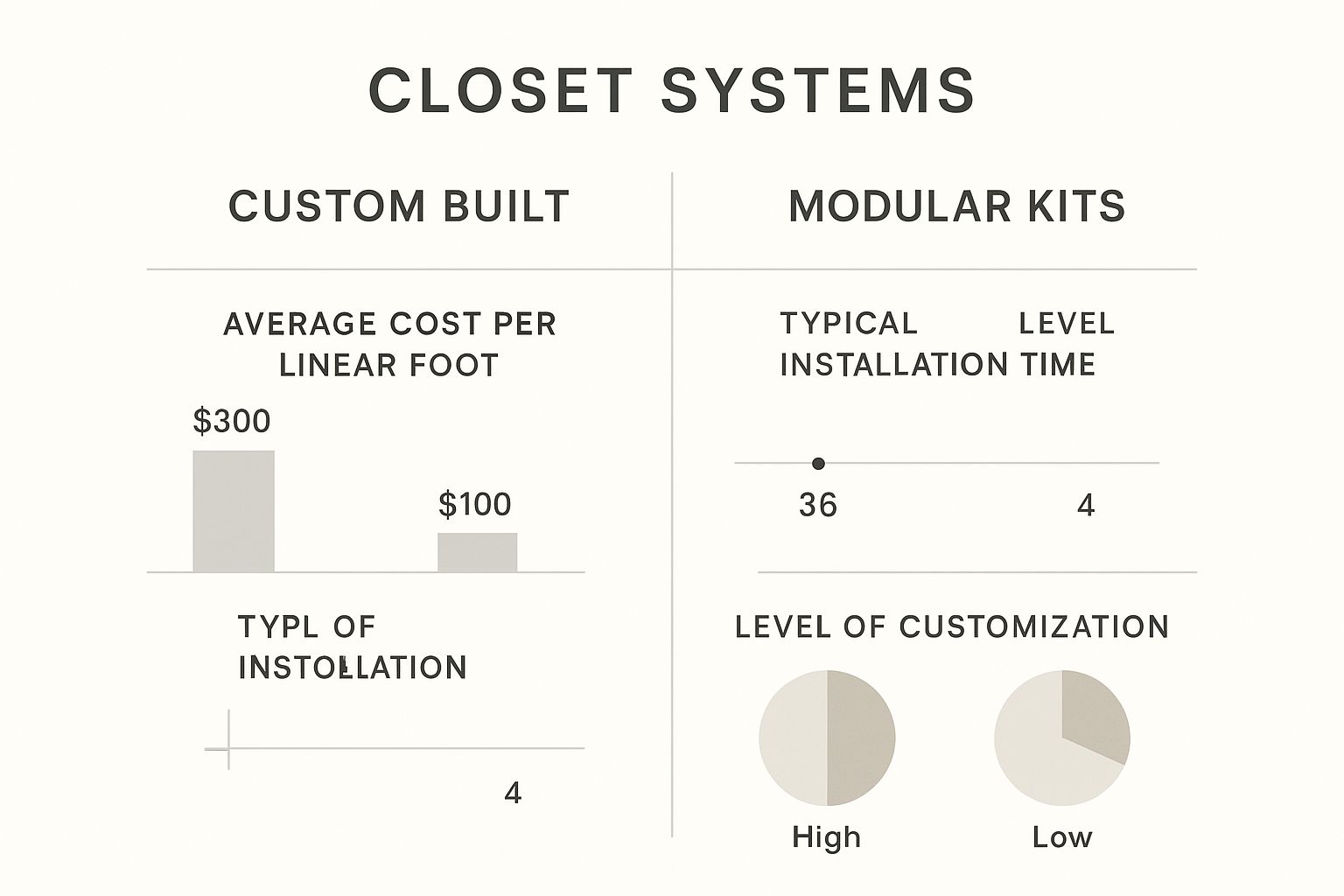
As you can see, modular systems are much more accessible in terms of cost and time, while custom builds offer the ultimate in personalization for those with a larger budget.
DIY Solutions: The Hands-On Approach
Going the do-it-yourself route gives you the most control and, for many, the most personal satisfaction. This path can be as simple as adding extra shelves and rods from a hardware store or as complex as building a full system from raw materials like wood and industrial pipes. The only limits are your own imagination, skills, and toolset.
A DIY approach is a fantastic choice if you're on a tight budget or just love a good hands-on project. You can tailor every single detail to your exact needs, creating unique solutions that you just can't buy off a shelf. For a bit of inspiration, our own MORALVE Rail System is a perfect starting point for a DIY project, offering a sturdy base to build upon.
Of course, this option demands careful planning, precise measurements, and a solid grasp of basic carpentry. It’s definitely the most time-consuming of the three, but the pride you feel from building your own perfect closet is a reward all its own.
Closet Systems At a Glance
To make the decision a little easier, here’s a quick breakdown of how these three systems stack up against each other.
| System Type | Best For | Average Cost | Flexibility | Installation |
|---|---|---|---|---|
| Modular | Renters, evolving needs, and budget-conscious homeowners. | $500 - $2,500 | High - can be reconfigured or added to over time. | DIY-friendly, with professional installation available. |
| Custom-Built | Homeowners with unique spaces, large wardrobes, or seeking a premium, permanent solution. | $3,000 - $10,000+ | Low - designed for a specific space and not easily changed. | Professional installation required. |
| DIY | Budget-focused individuals, creative problem-solvers, and those with specific, unique needs. | $100 - $1,000+ | Very High - limited only by your skill and imagination. | Requires personal time, skill, and tools. |
Ultimately, whether you choose the adaptability of a modular system, the precision of a custom build, or the creative freedom of a DIY project, the goal is the same: creating a space that works for you.
What to Look for in a Closet Organizer
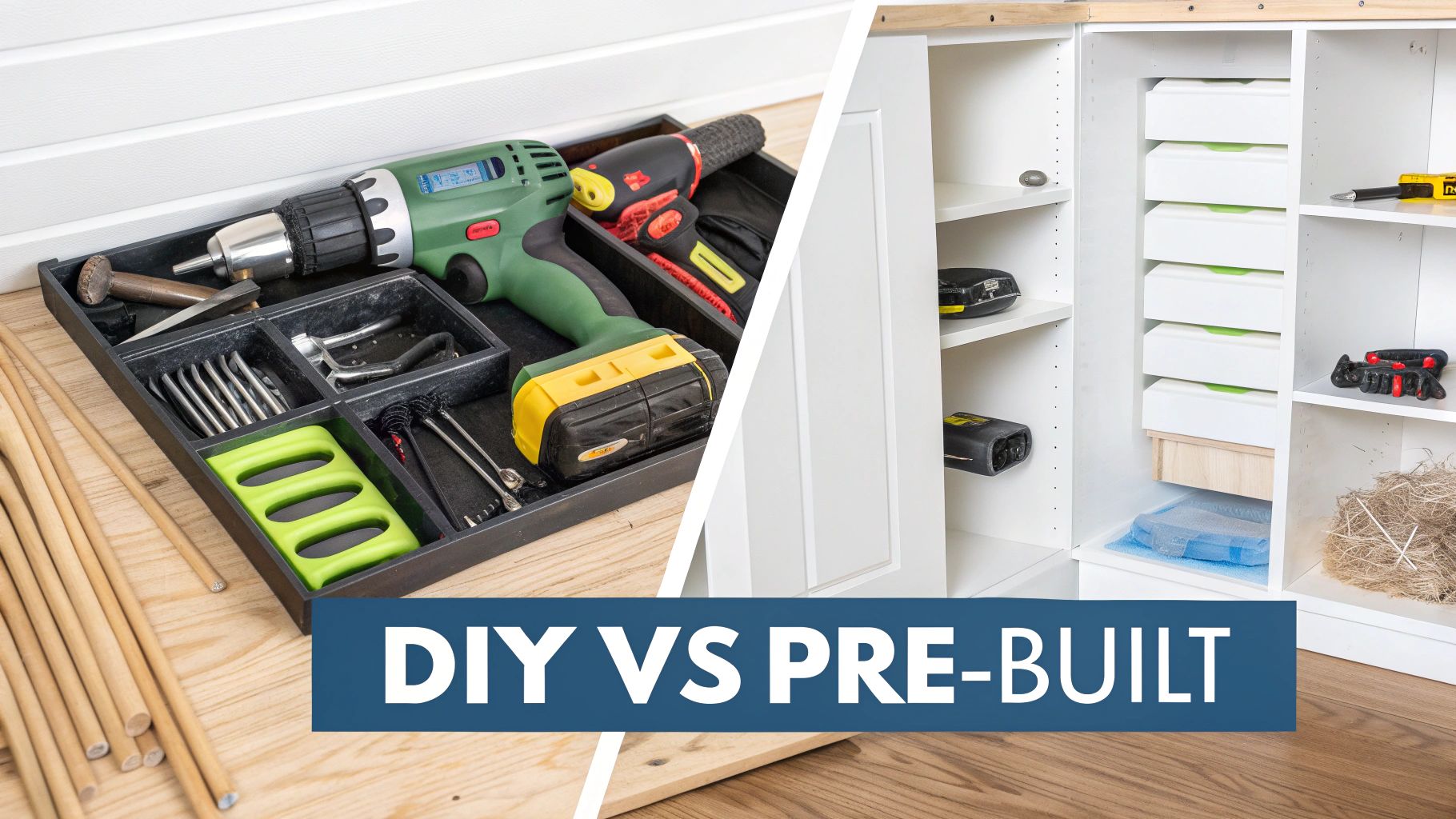
So, what really separates a decent closet system from a truly fantastic one? It’s not just about having a bar to hang your shirts. The difference lies in the smart, thoughtful features that make getting ready in the morning feel effortless. The best systems are built with flexibility in mind, transforming a simple storage space into a powerhouse of efficiency that works for you.
Once you move past the basic structure, the real game-changers are in the details. Things like adjustable components, durable materials, and clever storage add-ons are what make a system indispensable. These elements ensure your closet can evolve as your life does, protecting your investment and keeping your space perfectly organized for years.
The Foundation: Adaptability and Adjustability
If there's one non-negotiable feature in a modern closet system, it's adaptability. Think about it—your wardrobe is constantly in flux. It changes with the seasons, your job, and your personal style. A rigid, one-size-fits-all system that works today could easily become a source of frustration a year from now.
This is exactly why adjustable components are so critical. You need a system that can pivot when you do. Look for features like:
- Adjustable Shelving: The ability to move shelves up or down is a must. This lets you make room for bulky sweaters in the winter and then reconfigure for stacks of t-shirts in the summer, making sure no vertical space goes to waste.
- Movable Hanging Rods: Being able to change the height of your hanging rods is huge. It allows you to create dedicated zones for long coats and dresses, then add double-hanging rods to instantly double your capacity for shirts and folded pants.
A closet system should work for you, not the other way around. Adjustability means the system can grow and change right alongside your wardrobe, preventing the need for a complete overhaul every few years.
This core principle of flexibility is why modular systems have become so popular. They are designed from the ground up to be reconfigured, ensuring your closet always feels like a perfect fit.
Material Matters: Durability and Style
The material you choose for your closet system does more than just look pretty—it determines how long it will last and how well it stands up to daily wear and tear. It’s all about finding the right balance between your budget, your personal style, and practical function.
- Wire Shelving: This is definitely the most budget-friendly option. It's lightweight and promotes great airflow, which helps prevent mustiness. The downside? It can leave indentations on delicate fabrics and might start to sag over time under a lot of weight.
- Laminate (MDF): A fantastic mid-range choice, laminate gives you a smooth, solid surface that looks much more polished than wire. It comes in a ton of different colors and wood-grain finishes, so you can get a custom look without the hefty price tag of solid wood. Plus, it’s sturdy and a breeze to clean.
- Solid Wood: This is the premium option. Solid wood offers unparalleled durability and a genuinely luxurious, high-end feel. While it’s the biggest investment, a well-made wood system can last a lifetime and even add value to your home.
Ultimately, your choice of material sets the entire tone for your closet. For most people, laminate hits that sweet spot of cost, durability, and style.
Specialized Components for Ultimate Organization
Okay, this is where the real magic happens. Specialized components are the little secret weapons that solve those nagging storage problems and bring a true sense of order to your clothes and accessories. Instead of just general-purpose shelves, these features create a specific home for every single item.
Consider adding elements like:
- Drawer Dividers: Absolutely essential for keeping socks, underwear, and smaller accessories from becoming a jumbled mess.
- Shoe Racks or Shelves: Whether they’re angled shelves or pull-out racks, they get your shoes off the floor and let you see your entire collection at a glance. No more crushed footwear!
- Pull-Out Pants Hangers: These are brilliant. They keep trousers and slacks perfectly creased and let you grab the pair you want without digging through a crowded closet rod.
- Tie and Belt Racks: So simple, yet so effective. These slide-out racks keep all your accessories organized and tangle-free.
Even something as simple as your choice of hangers can make a massive difference. To learn more, check out our guide on the best space-saving hangers and see how you can maximize every last inch of hanging space. When you match these components to what you actually own, you create a system that's truly, and beautifully, your own.
How to Plan Your New Closet Layout
A great closet doesn't just happen; it starts with a solid plan, long before you add a single shelf to your online cart. Before you can pick the right organization system, you have to get to know the space you're working with. Think of this planning phase as your blueprint for success—it’s what guarantees the final result feels intuitive, efficient, and perfectly suited to you.
Jumping straight into buying components without a plan is like starting a road trip without a map. Sure, you'll end up somewhere, but it probably won't be where you wanted to go. Taking a little time to measure, inventory, and visualize your layout is the key to building a closet that feels custom-made from day one.
Start With Accurate Measurements
First things first, you need the exact dimensions of your closet. Grab a tape measure and a notepad, and let's get the key numbers down.
- Width: Measure the back wall's width at the top, middle, and bottom. Walls are rarely perfectly straight, so always use the smallest number to ensure everything fits.
- Height: Measure from the floor to the ceiling on both the left and right sides.
- Depth: Measure from the back wall out to the front edge of the closet opening.
- Obstructions: Make a note of any obstacles—light fixtures, outlets, sloped ceilings—and their exact location and size.
With these measurements, you have your canvas. This simple step prevents the all-too-common headache of buying a system that’s too big or doesn't account for your closet’s unique quirks.
Take a Complete Wardrobe Inventory
Next up, you need to know exactly what you’re organizing. After all, a closet built for a shoe fanatic will look completely different from one designed for someone with a collection of long coats. It’s time to lay everything out and take stock.
Sort your items into categories to see what you have the most of. Do you need tons of hanging space for dresses and suits, or is your wardrobe mostly folded sweaters and jeans? Count your shoes, handbags, and smaller accessories like belts and scarves.
This isn't just about counting clothes; it's about truly understanding your storage needs. Realizing you need 30 inches of double-hanging space for shirts but only 15 inches for long dresses can completely change your entire layout.
Map Out Your Vision
Now for the fun part—bringing your plan to life. Start by sketching a simple diagram of your closet on paper, marking in the dimensions you just measured. From there, begin blocking out different "zones" for each clothing category based on your inventory.
Here’s a fantastic practical trick: use painter's tape on the actual closet walls. Mark out where you imagine shelves, drawers, and hanging rods will go. This gives you a tangible feel for the scale and spacing, helping you see if the plan feels right before you commit. You might realize those drawers would feel too cramped, or discover you have way more room for shoe shelves than you initially thought.
For a deeper dive, our complete guide on how to design a closet walks you through even more strategies to refine your layout.
This kind of careful planning is becoming more popular as people see the real value in an organized home. The global market for closet organizers is booming, reflecting a major shift toward smarter space management. Valued at roughly USD 4.03 billion in 2025, the market is projected to hit USD 8.53 billion by 2035, thanks in large part to a growing home renovation culture. You can read more about these trends at Future Market Insights. By following a clear plan, you’re not just organizing a closet—you’re creating a genuinely beautiful and functional space.
Exploring High-End Custom Closet Solutions
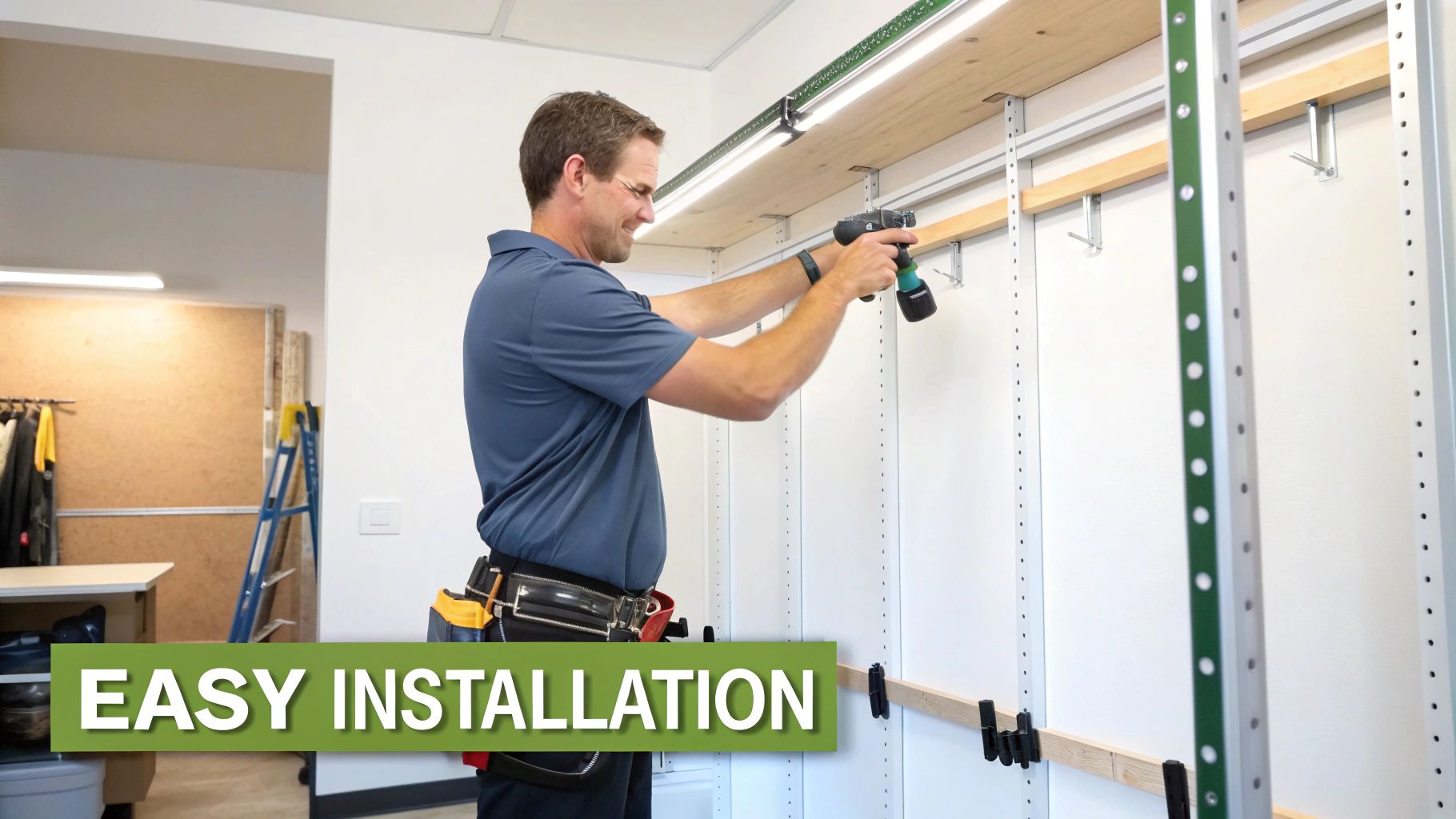
When you move past the off-the-shelf kits, you step into a completely different world: high-end custom closet solutions. This is where organization becomes an art form. Your closet stops being just a place to store clothes and transforms into a personal sanctuary, built precisely for your life and your style. Think of it less like buying furniture and more like commissioning a piece of fine, built-in cabinetry for your home.
The real magic of a custom closet is its ability to use every single inch of space. Professional designers can work around any architectural oddity—sloped ceilings, awkward corners, you name it—to create a system that fits perfectly. Nothing is wasted. This personalization goes way beyond the layout, extending to every material, finish, and feature you can imagine.
The Hallmarks of Luxury Organization
What really sets a high-end closet apart are the thoughtful details and impeccable craftsmanship. These aren't just functional spaces; they're designed to make your daily routine feel a little more special and a lot less chaotic. The focus shifts from merely storing items to beautifully presenting and preserving your wardrobe.
You'll know you're in a premium space when you see features like these:
- Integrated LED Lighting: Smartly placed lighting does more than just help you see. It creates a gorgeous visual display, turning your collection into a focal point.
- Velvet-Lined Jewelry Drawers: Custom-fitted dividers and soft linings keep delicate watches, necklaces, and earrings safe from scratches and tangles. No more untangling chains!
- High-End, Sustainable Materials: The feel of solid wood or the sleek look of premium laminates gives the space a sense of permanence and sophistication that can add real value to your home.
- Glass-Front Doors and Drawers: These give your closet a boutique feel, letting you admire your favorite shoes or handbags while keeping them perfectly protected from dust.
This desire for quality and personalization is really catching on. The global custom closets market was valued at a huge USD 11.7 billion in 2023 and is expected to more than double to USD 25.4 billion by 2033. That's a clear sign that homeowners are craving this kind of luxury storage. You can dig into the numbers yourself with this report from DataHorizzon Research.
Investing in a Personal Sanctuary
Opting for a high-end custom closet is about more than just getting organized. It’s a genuine investment in your home and your daily life. A beautifully designed, luxurious closet is a major selling point for a house, showing a level of care and quality that buyers notice immediately.
A custom closet system moves beyond simple utility. It becomes a reflection of your personal style and a space that brings a sense of calm and order to your daily life, turning the act of getting dressed into a truly pleasant experience.
In the end, this route is for homeowners who see organization as a core part of their home's overall design. By blending expert craftsmanship with features built just for you, a custom solution delivers one of the best closet organization systems you can possibly have.
Upgrading Your Closet as a Home Investment
Think of a closet renovation as more than just a weekend project to declutter. It’s actually one of the smartest home improvements you can tackle. You're not just tidying up; you're making a real investment that boosts your daily routine and your home's long-term value.
When you start seeing your closet upgrade as a strategic move, everything changes. That messy, frustrating space isn't just a problem anymore—it's an opportunity. A thoughtfully designed closet can give your home a serious edge, making it much more attractive in a crowded real estate market.
From Awkward Space to Standout Feature
A lot of homes, especially older ones, have their share of quirks—think slanted ceilings, weird nooks, or random bump-outs. These areas often turn into dead space, completely wasting valuable storage potential. But the best closet organization systems are built to solve exactly these kinds of problems, turning an awkward corner into a powerhouse of efficiency.
In a brand new home, a well-planned walk-in closet can be a showstopper. It can be just as appealing to potential buyers as a state-of-the-art kitchen or a sparkling new bathroom, signaling a real commitment to quality and smart design.
This is a huge reason behind the home renovation boom we're seeing. Closet organizers are a big piece of the puzzle as people look to modernize and personalize their homes. In fact, the U.S. home renovation market hit USD 472 billion in 2022 and is expected to climb past USD 485 billion by 2024. That's a massive trend, and better storage is right at the heart of it. You can dive deeper into the growth of the closet organizer market at ResearchAndMarkets.com.
Converting a Spare Room into a Dream Closet
Thanks to modern modular systems, it’s easier than ever to think outside the traditional closet box. Do you have a spare bedroom that’s underused or a den that’s become a catch-all for clutter? These are perfect spaces to transform into a luxurious walk-in closet or a full-blown dressing room.
An organized, well-designed closet is no longer just a feature; it's a lifestyle upgrade. It adds a touch of daily luxury while contributing tangible value to your property.
A project like this can be surprisingly simple with the right system. Modular pieces let you create a high-end, custom-looking closet without the headache and high cost of a major structural renovation. You can design dedicated zones for shoes, bags, seasonal clothing—whatever you need.
Ultimately, looking at your closet project as an investment is empowering. It’s not just an expense; it’s a smart upgrade that pays you back every day with less stress, more convenience, and a higher home value. By putting a little money and thought into one of the most-used spaces in your home, you're investing in a more organized life and a more valuable asset.
Your Top Closet System Questions, Answered
Starting a closet makeover can feel like a big step, and it's natural to have a few last-minute questions. We've been there. To help you get started with total confidence, here are some straightforward answers to the questions we hear most often.
Think of this as your final check-in before diving in. Getting these details sorted out is the key to choosing a system that fits your space, your stuff, and your budget perfectly.
What's the Most Flexible Type of Closet Organizer?
Without a doubt, modular systems offer the most versatility. Their real magic is in their adaptability—you can add new shelves, move hanging rods, or totally reconfigure the layout as your needs change. This makes them a fantastic choice for renters, kids' closets that need to evolve, or anyone who likes to switch things up.
Unlike a built-in system that’s there for good, you can even pack up a modular closet and take it with you when you move. It's an investment that truly lasts.
How Much Should I Budget for a New Closet System?
The price tag on a new closet system can swing wildly, so it’s smart to figure out your budget before you start shopping.
- DIY Wire Kits: These are your most wallet-friendly option, usually falling between $100 and $200.
- Mid-Range Modular Systems: For a solid laminate or wood veneer system in a standard closet, you can expect to spend anywhere from $500 to $2,000.
- Professionally Installed Custom Closets: This is the top-tier choice. Costs typically start around $2,500 but can easily climb past $10,000 for large walk-ins with all the bells and whistles.
A closet upgrade is more than just an expense; it's an investment in your home and your daily sanity. The upfront cost pays you back in convenience and can even add to your home's value.
Can I Install a Closet System on My Own?
You sure can. Most modular and wire systems are designed with the DIYer in mind, complete with instructions and all the hardware you'll need. If you know your way around a drill, a level, and a tape measure, you can definitely save a good chunk of change on installation.
That said, for complex custom jobs that require perfect cuts and a seamless look, calling in a professional is the best move. It ensures a sturdy, polished finish that looks like it was always meant to be there.
How Do I Deal with a Closet That Has a Weird Shape?
Sloped ceilings, odd corners, and shallow depths are exactly where modular components prove their worth. Since the system is made of individual pieces, you can get creative and build around obstacles, using vertical space that a one-size-fits-all unit could never touch. It’s the perfect way to turn a challenging space into a storage powerhouse.
For those truly unique spaces with tricky dimensions, a fully custom solution is the ultimate problem-solver. A designer can create a plan that fits every single nook and cranny, making sure no inch goes to waste.
Ready to build a more organized life? It all starts with the right foundation. At MORALVE, our space-saving hangers and smart organizers are designed to help you get the most out of any system you choose. Explore our collection at https://moralve.com and take that first, satisfying step toward a closet that just works.
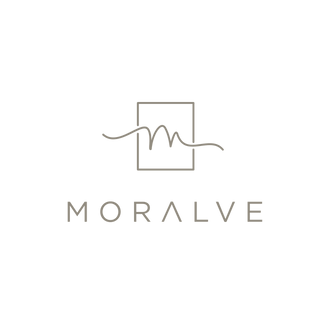

Leave a comment